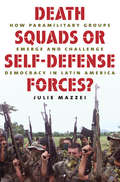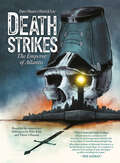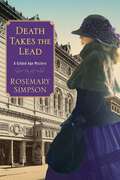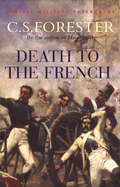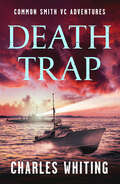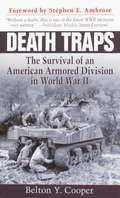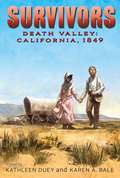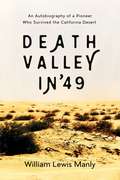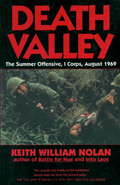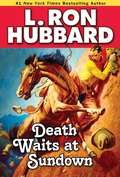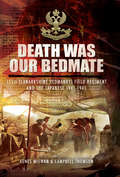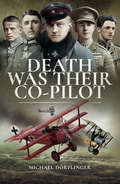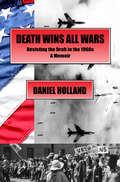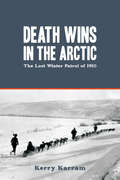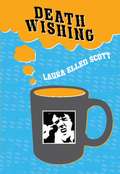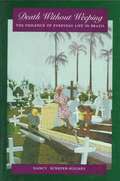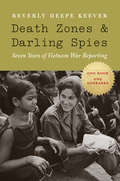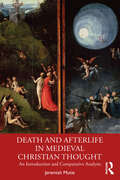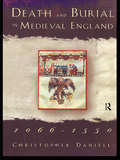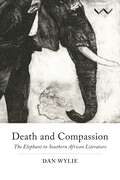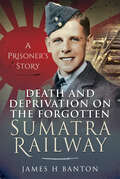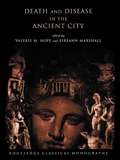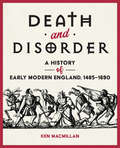- Table View
- List View
Death Squads or Self-Defense Forces?: How Paramilitary Groups Emerge and Challenge Democracy in Latin America
by Julie MazzeiIn an era when the global community is confronted with challenges posed by violent nonstate organizations--from FARC in Colombia to the Taliban in Afghanistan--our understanding of the nature and emergence of these groups takes on heightened importance. Julie Mazzei's timely study offers a comprehensive analysis of the dynamics that facilitate the organization and mobilization of one of the most virulent types of these organizations, paramilitary groups (PMGs). Mazzei reconstructs in rich historical context the organization of PMGs in Colombia, El Salvador, and Mexico, identifying the variables that together create a triad of factors enabling paramilitary emergence: ambivalent state officials, powerful military personnel, and privileged members of the economic elite. Nations embroiled in domestic conflicts often find themselves stuck between a rock and a hard place when global demands for human rights contradict internal expectations and demands for political stability. Mazzei elucidates the importance of such circumstances in the emergence of PMGs, exploring the roles played by interests and policies at both the domestic and international levels. By offering an explanatory model of paramilitary emergence, Mazzei provides a framework to facilitate more effective policy making aimed at mitigating and undermining the political potency of these dangerous forces.
Death Strikes: The Emperor of Atlantis
by Dave MaassMixing dystopian sci-fi, mythic fantasy, and zombie horror, Death Strikes: The Emperor of Atlantis, is a graphic novel based on a suppressed opera written in 1943 by Peter Kien and Viktor Ullmann, two prisoners at the Terezín concentration camp in Czechoslovakia. The authors did not live to see their masterpiece performed.Set in an alternative universe where Atlantis never sank but instead became a technologically advanced tyranny, the power-mad buffoonish Emperor declares all-out war—everyone against everyone. Death goes on a labor strike, creating a hellscape where everyone fights, but no one dies. Can the spirit of Life stop this terror with the power of love?Includes designs from the original opera, historical essays, photographs, and more."This is beautiful and strange, both for what it is and what it isn't. As a story it's fascinating and excellently told, as an artifact it's heartbreaking and affecting. More than a footnote in Holocaust literature or a lost libretto given visual shape, it's a reminder of what art is for, and how it saves and shapes us when everything else is gone.&”—Neil Gaiman&“Maass&’s playful script, with its pitch-black humor and fiendish turns of phrase, honors the original opera... This parable captures the defiant spirit of artists.&”—Publishers Weekly
Death Takes the Lead (Gilded Age Mystery #9)
by Rosemary SimpsonWhen a series of mysterious deaths plagues a new Scottish play, heiress and lawyer Prudence MacKenzie and her partner ex-Pinkerton Geoffrey Hunter are called in to perform an investigation at one of Broadway&’s most stunning theatres . . . DEATH TAKES THE LEAD APRIL 1891: Prudence MacKenzie is delighted to attend a riveting rehearsal of Waif of the Highlands with her dear friend, Lydia Truitt, whose cousin, Septimus Ward, stars in the play. But the drama continues after the curtain falls, as the women overhear a ferocious argument between Septimus and the play&’s famous playwright-director, Barrett Hughes. When confronted about the dispute, Septimus reveals that he actually wrote the script, but allowed Hughes to claim authorship in return for casting Septimus&’s paramour, Flora Campbell, in the lead. Septimus has come to regret the agreement and vows to reclaim authorship, even if it means the play never opens. But, days later, Prudence and Geoffrey are urgently summoned to Septimus&’s boarding house, where the thespian lays dying in Lydia&’s arms. Lydia believes her cousin&’s death is no accident and wants Hunter and MacKenzie Investigative Law to look into the matter, going so far as to help Prudence and Flora secure employment undercover in the play&’s wardrobe department. At first, Hughes&’s determination to keep the production running seems admirable, but his motives are soon called into question as Prudence hears whispers backstage about his notorious predatory behavior with young women. And when another body turns up at the theatre, it&’s clear that someone is targeting the play and its company—but why? Prudence and Geoffrey must improvise as they tread into an unfamiliar world where deceit is cultivated for entertainment and deception is celebrated as talent, to expose a darkness lurking behind the glittering stage lights. . .
Death To The French
by C. S. ForesterA stand-alone novel that inspired Bernard Cornwell's Sharpe seriesIt is 1810, and the last French invasion of Portugal has penned Wellington's army behind the river Tagus with their backs to the sea.Separated from his regiment, Rifleman Dodd of the Ninety-Fifth stumbles on a band of undisciplined Portuguese guerrillas. With rough inventiveness he transforms this ramshackle group into an organised fighting force, continually harrying the infuriated enemy as he battles his way back to his own lines.Written by the author of the Hornblower series, DEATH TO THE FRENCH is a classic novel of the Peninsular War, and was the inspiration for Bernard Cornwell's Sharpe books.
Death To The French
by C. S. ForesterA stand-alone novel that inspired Bernard Cornwell's Sharpe seriesIt is 1810, and the last French invasion of Portugal has penned Wellington's army behind the river Tagus with their backs to the sea.Separated from his regiment, Rifleman Dodd of the Ninety-Fifth stumbles on a band of undisciplined Portuguese guerrillas. With rough inventiveness he transforms this ramshackle group into an organised fighting force, continually harrying the infuriated enemy as he battles his way back to his own lines.Written by the author of the Hornblower series, DEATH TO THE FRENCH is a classic novel of the Peninsular War, and was the inspiration for Bernard Cornwell's Sharpe books.
Death Trap (Common Smith VC Adventures)
by Charles WhitingCommon Smith is in a race against time to retrieve sensitive British intelligence before it falls into enemy handsYugoslavia, Winter 1924. The British official courier plane from Cairo to Gibraltar has been forced down in the mountains off the Yugoslavian coast by snow.The plane was on its way to London bearing vital documents about Moscow's plans for the Balkans, including an uprising in Yugoslavia. It is vital that no one finds these plans, including the Royal Yugoslavian Secret Police, for they too have communist sympathisers in their ranks.Now, in a race against time, Common Smith and the crew of theSwordfishmust sail to the island of Vis, then up the River Dvar and smuggle themselves into the snow-bound mountains. Their mission: recover the British airmen and the sensitive documents they were carrying.But the elements and Yugoslavian Secret Police are not the only forces Common Smith is contending with. A mysterious Communist leader is hiding out in these mountains with his men, and they know about the crash too...A gripping, edge-of-your-seat race against time from one of the masters of military adventure fiction.
Death Traps: The Survival of an American Armored Division in World War II
by Belton Y. Cooper"Cooper saw more of the war than most junior officers, and he writes about it better than almost anyone. . . . His stories are vivid, enlightening, full of life--and of pain, sorrow, horror, and triumph."--STEPHEN E. AMBROSE From his Foreword"In a down-to-earth style, Death Traps tells the compelling story of one man's assignment to the famous 3rd Armored Division that spearheaded the American advance from Normandy into Germany. Cooper served as an ordnance officer with the forward elements and was responsible for coordinating the recovery and repair of damaged American tanks. This was a dangerous job that often required him to travel alone through enemy territory, and the author recalls his service with pride, downplaying his role in the vast effort that kept the American forces well equipped and supplied. . . . [Readers] will be left with an indelible impression of the importance of the support troops and how dependent combat forces were on them."--Library Journal"[DEATH TRAPS] FILLS A CRITICAL GAP IN WW2 LITERATURE. . . . IT'S A TRULY UNIQUE AND VALUABLE WORK."--G.I. JournalFrom the Paperback edition.
Death Valley
by Kathleen Duey Karen A. BaleA brother and sister struggle to survive a harrowing trip across Death Valley--the most dangerous part of the Mojave Desert and the hottest spot in North America--in this riveting tale of historical fiction, part of the Survivors series.California, 1849: Jess, Will, and their father are in grave danger--separated from the rest of their west-bound party, their wagon is useless with a broken axle, and Pa is seriously ill from an injury that Will feels is his fault.In a valiant attempt to save their family, Will and Jess set off on foot over the endless sands to find help. Each day of their journey brings a new peril, but nothing more frightening than the constant, overpowering thirst that muddles their minds and threatens their very will to survive. With so much at stake, can Will and Jess win their desperate battle with the unrelenting desert?
Death Valley in '49: An Autobiography of a Pioneer Who Survived the California Desert
by William ManlyA survivor’s true account of death, despair, and heroism in Death Valley in the heat of the California Gold Rush. At the height of the California gold rush in 1849, a wagon train of men, women, children, and their animals stumbled into a 130-mile-long valley in the Mojave Desert while they were looking for a shortcut to the California coast. What ensued was an ordeal that divided the camp into remnants and struck them with hunger, thirst, and a terrible sense of being lost beyond hope—until a twenty-nine-year-old hero volunteered to cross the desert to get help. This young hero, William Lewis Manly, was one of the survivors of the tragedy, and he lived to tell the tale forty-five years later in this gripping autobiography, first published in 1894. In a time of unmarked frontiers and wilderness, Manly lived the true life of a pioneer. After being hit by gold rush fever Manly joined the fateful wagon train that would get swallowed up by the barren, arid, hostile valley with its dry and waterless terrain, unearthly surface of white salts, and overwhelming heat. Assaulted and devastated by the elements, members of the camp killed their emaciated oxen for food, ran out of water, split up, and lost and buried their own kind who perished. When Manly’s remaining band of ten came across a rare water hole, he and a companion, John Rogers, left the rest by the water and crossed the treacherous Panamint Mountains and Mojave Desert by themselves in search for rescue. In a true act of heroism against all odds, the two finally returned twenty-five days later with help, rescuing their compatriots, including four children, even when it seemed all hope was lost. Told at the end of the nineteenth century, Manly’s compelling and stirring account brings alive to modern-day readers the unimaginable hardships of America’s brave pioneers, and a chapter in Californian history that should not be forgotten.
Death Valley: The Summer Offensive, I Corps, August 1969
by Keith NolanAuthor of the well received Battle for Hue and Into Laos, Nolan once again captures the stark reality of combat in Vietnam.
Death Waits at Sundown
by L. Ron HubbardSaddle up for excitement with this riveting tale. When Lynn Taylor's kid brother, Lee, gets framed for stage robbery, cattle rustling and murder, the boy swears his innocence and instead accuses McCloud, head of the vigilante committee responsible for removing the town's former sheriff.To save Lee from hanging the following night, Lynn hatches a wild plan to rob the next stagecoach with the help of the ex-sheriff--hoping it will raise doubts about Lee's guilt if the crimes continue. But Lynn gets more than he bargained for when he's snared by McCloud's men, and the time to the hanging gallops rapidly his way. ALSO INCLUDES THE WESTERN STORIES "RIDE 'EM COWBOY" AND "THE BOSS OF THE LAZY B""Hubbard's trio has one thing in common--rough and tumble action with a twist, and all are a great read." --True West Magazine * An International Book Awards Winner
Death Was Our Bedmate: 155 (Lanarkshire Yeomanry) Field Regiment and the Japanese 1941–1945
by Agnes McEwan Campbell ThompsonThe book tells the story of a little known artillery regiment, the 155th (Lanarkshire Yeomanry) Field Regiment, RA which saw constant action during the ill-fated Malayan Campaign of 1941/42 and whose members later experienced the worst kind of hell as POWs of a cruel and bestial enemy.Following the Japanese invasion of Malaya, the Regiment fought a brave and resolute rearguard action all the way down the Malayan Peninsular and onto the so called impregnable fortress of Singapore. Held in the highest respect by comrades and foe alike, this former territorial cavalry regiment fully deserved its Royal Artillery moto Ubigue everywhere.In the years that followed, the Gunners slaved, suffered an d died on the infamous Burma Railway, in copper mines of Formosa and camps throughout the Far East. More men of the Regiment died as POWs than fell in action. They should not be forgotten.Included is a full nominal roll which allows the reader to identify the camp/s where each individual Gunner was held. A Roll of Honour provides the date, place and cause of death and place of burial/commemoration of the Regiments casualties.
Death Was Their Co-Pilot: Aces of the Skies
by Michael DorflingerIt was in World War I that the skies first became a battlefield, with nations seeking to decide military outcomes off the ground. This volume introduces the fighter pilots of World War I, including the infamous Red Baron Manfred von Richthofen. In addition to this iconic flying ace, the author presents the thrilling biographies of numerous others and recounts their exploits and the tragedies they suffered. Likewise, the book illustrates the Great Wars historical background and documents the increasing sophistication of aviation technology and warfare.
Death Wins All Wars: Resisting the Draft in the 1960s, a Memoir
by Daniel HollandWhile Daniel Holland's memoir details his involvement in the draft resistance movement of the 1960s, the impetus to share his story now comes from the dangerous new president and congress that have taken control of the United States Government. There is no telling how quickly they will plunge our nation into war. People who are of age to fight in the wars of today were not yet born when the lessons of Vietnam were being learned, so this book may serve as a guide to the decisions they face in today's volatile world. Holland's chapters highlighting the headlines and breaking news of the time alternate with coming of age rites-of-passage chapters as his personal memories and current reflections on those events portray a growing consciousness and his evolution of youthful naiveté into committed antiwar activism. Then his focus turns to the legal adventures that follow: indictment, arrest, arraignment, defending himself at trial, and sentencing. Interspersed with these, he shares episodes of draft board raids, secret rooms, and the day-to-day responsibilities of a full-time activist. He follows a surprise ending with a thoughtful afterword contemplating our personal responsibilities for peace.
Death Wins in the Arctic: The Lost Winter Patrol of 1910
by Kerry KarramA harrowing tale of human intelligence pitted against the forces of nature. With prospectors, trappers, and whalers pouring into northwestern Canada, the North West Mounted Police were dispatched to the newest frontier to maintain patrols, protect indigenous peoples, and enforce laws in the North. In carrying out their duties, these intrepid men endured rigorous and dangerous conditions.On December 21, 1910, a four-man patrol left Fort McPherson, Northwest Territories, heading for Dawson City, Yukon, a distance of 670 kilometres. They never arrived. The harrowing drama of their 52-day struggle to survive is an account of courageous failure, one that will resonate strongly in its depiction of human intelligence pitted against the implacable forces of nature. Based on Fitzgerald’s daily journal records, Death Wins in the Arctic tells of their tremendous courage, their willingness to face unthinkable conditions, and their dedication to fulfill the oath they took. Throughout their ordeal, issues of conservation, law enforcement, Aboriginal peoples, and sovereignty emerge, all of which are global concerns today.
Death Wishing
by Laura Ellen Scott"This is a terrific story, beautifully written, and completely enthralling."--Dorothy Allison In post-Katrina New Orleans, dying wishes can cure cancer, eliminate cats, bring back Elvis (1968 vintage), and turn the clouds orange. Divorced and disgraced up north, Victor hopes to live a carefree, drunken existence in the French Quarter, making capes and corsets and lusting for the girl who lives across the street--until the hysteria surrounding "death wishing" changes his world in ways he never imagined. Laura Ellen Scott teaches fiction writing at George Mason University. Her work has been selected for The Wigleaf Top Fifty of 2009 and Barrelhouse magazine's "Futures" issue. She has twice been nominated for Dzanc's Best of the Web 2010 anthology.
Death Without Weeping: The Violence Of Everyday Life In Brazil
by Nancy Scheper-HughesDeath Without Weeping is a work of passion, a nontraditional ethnography charged with political commitment and moral vigor. It is a tour de force that will be discussed and debated for many years to come.
Death Zones and Darling Spies: Seven Years of Vietnam War Reporting (Studies in War, Society, and the Military)
by Beverly Deepe KeeverChosen for 2015 One Book One NebraskaIn 1961, equipped with a master&’s degree from famed Columbia Journalism School and letters of introduction to Associated Press bureau chiefs in Asia, twenty-six-year-old Beverly Deepe set off on a trip around the world. Allotting just two weeks to South Vietnam, she was still there seven years later, having then earned the distinction of being the longest-serving American correspondent covering the Vietnam War and garnering a Pulitzer Prize nomination.In Death Zones and Darling Spies, Beverly Deepe Keever describes what it was like for a farm girl from Nebraska to find herself halfway around the world, trying to make sense of one of the nation&’s bloodiest and bitterest wars. She arrived in Saigon as Vietnam&’s war entered a new phase and American helicopter units and provincial advisers were unpacking. She tells of traveling from her Saigon apartment to jungles where Wild West–styled forts first dotted Vietnam&’s borders and where, seven years later, they fell like dominoes from communist-led attacks. In 1965 she braved elephant grass with American combat units armed with unparalleled technology to observe their valor—and their inability to distinguish friendly farmers from hide-and-seek guerrillas.Keever&’s trove of tissue-thin memos to editors, along with published and unpublished dispatches for New York and London media, provide the reader with you-are-there descriptions of Buddhist demonstrations and turning-point coups as well as phony ones. Two Vietnamese interpreters, self-described as &“darling spies,&” helped her decode Vietnam&’s shadow world and subterranean war. These memoirs, at once personal and panoramic, chronicle the horrors of war and a rise and decline of American power and prestige.
Death and Afterlife in Medieval Christian Thought: An Introduction and Comparative Analysis
by Jeremiah MutieDeath and Afterlife in Medieval Christian Thought explores how medieval Christians conceived the changing ideas of death and what happens thereafter to both the material and immaterial aspects of a person.Where much scholarship has addressed this topic from a Western point of view, this book asks how these ideas emerged and progressed over this long period of time in both Western and Eastern medieval Christianities. The work examines the two leading motifs of death and the afterlife in Western medieval Christian thought: Purgatory and the cult of the saints. It then proceeds to shift the spotlight to conceptions of death in Eastern Christianity, all the while maintaining a comparative approach. This book not only delves into the theoretical, but draws on archaeological evidence, such as artefacts, to provide a broader view of the evidence. Ultimately, it finds that medieval Christians continued the process that started in Christianity’s earliest days of borrowing and modifying existing ideas of death and the afterlife in order to produce a distinctive and sophisticated Christian set of beliefs.As an accessible introduction, this book stands as a valuable resource to students, scholars and all readers interested in early medieval Christianity, the history of ideas, and the history of death.
Death and Afterlife in the Pages of Gregory of Tours: Religion and Society in Late Antique Gaul (Social Worlds of Late Antiquity and the Early Middle Ages)
by Allen E. JonesGregory of Tours was a bishop of late antiquity who was famously devoted to promoting the efficacy of saintly powers. In his writings, both historical and hagiographical, Gregory depicted the saints and reprobates of his age. This book analyses Gregory's writings about death and the afterlife, thereby illuminating the bishop's pastoral imperative to save souls and revealing his opinions about the fates of Merovingian royals, among many others he mentions in his voluminous text. The study provides insight into Gallic peoples living at the dawning of the Middle Ages and their hopes and fears about the otherworld. It affords an original, nuanced interpretation of Gregory's motives for penning his works, particularly the Historiae, which remained unfinished upon the author's death.
Death and Burial in Medieval England 1066-1550: Null
by Christopher DaniellDeath had an important and pervasive presence in the middle ages. It was a theme in medieval public life, finding expression both in literature and art. The beliefs and procedures accompanying death were both complex and fascinating.Christopher Daniell's appproach to this subject is unusual 1n bringing together knowledge accumulated from historical, archaeological and literary sources. The book includes the very latest research, both of the author and of others working in this area. The result is a comprehensive and vivid picture of the entire phenomenon of medieval death and burial.
Death and Compassion: The Elephant in Southern African Literature
by Dan WylieTraces the literary history of the elephant, and its role in South Africa's cultural imaginaryElephants are in dire straits – again. They were virtually extirpated from much of Africa by European hunters in the eighteenth and nineteenth centuries, but their numbers resurged for a while in the heyday of late-colonial conservation efforts in the twentieth. Now, according to one estimate, an elephant is being killed every 15 minutes. This is at the same time that the reasons for being especially compassionate and protective towards elephants are now so well-known that they have become almost a cliché: their high intelligence, rich emotional lives including a capacity for mourning, caring matriarchal societal structures, that strangely charismatic grace. Saving elephants is one of the iconic conservation struggles of our time.As a society we must aspire to understand how and why people develop compassion – or fail to do so – and what stories we tell ourselves about animals that reveal the relationship between ourselves and animals. This book is the first study to probe the primary features, and possible effects, of some major literary genres as they pertain to elephants south of the Zambezi over three centuries: indigenous forms, early European travelogues, hunting accounts, novels, game ranger memoirs, scientists’ accounts, and poems. It examines what these literatures imply about the various and diverse attitudes towards elephants, about who shows compassion towards them, in what ways and why. It is the story of a developing contestation between death and compassion, between those who kill and those who love and protect.
Death and Deprivation on the Forgotten Sumatra Railway: A Prisoner's Story
by James H. BantonJames Henry Banton was born in Burton on Trent in 1920. He worked as a driver of a steam locomotive used to transport beer and supplies to breweries around the town. When war broke out Jim joined the RAF, eventually becoming a Leading Aircraftsman as part of the RAF’s ground crew. During this time Jim had met the love of his life Dorothy Mason. Jim didn't know that when he left Gladstone Dock in Liverpool he would not see home or his family including Dorothy for another four and a half years. Eventually posted to the Far East he was captured by the Japanese in the hills on the island of Java. Used as slave labour, starved, beaten and witnessing death on a daily basis he was later put to work on the building of the Sumatra Railway. The Far East Prisoners of war became known as the Forgotten Army, however there has been little reference paid to the Sumatra Railway compared with other theatres of WW2. With this in mind the prisoners who worked on the Sumatra Railway could be considered to be the ‘Forgotten of the Forgotten Army’. In August 1945 the world celebrated victory in Europe, however for the FEPOW’s the war dragged on. As parts of the world were trying to return to normality Jim and his colleagues were being made to dig their own graves in the Sumatra jungle. The FEPOW’s lives hung in the balance as orders had been issued to murder all POW’s should mainland Japan be invaded by the Allies. This book is Jim’s story and it is hoped it will also be a reminder not only of the sacrifice of the Forgotten Army but also highlight the suffering of the ‘Forgotten of the Forgotten Army’ – The Sumatra Railway POW’s.
Death and Disease in the Ancient City
by Valerie M. HopeFirst Published in 2004. Routledge is an imprint of Taylor & Francis, an informa company.
Death and Disorder: A History of Early Modern England, 1485–1690
by Ken MacMillanIn Death and Disorder, award-winning teacher Ken MacMillan introduces readers to the tumultuous world of Tudor and Stuart England. During this period, numerous kings and queens were killed, their advisors assassinated, treasonous nobles beheaded, religious heretics burned at the stake, and common criminals executed by hanging. Combined with devastating plagues, a high rate of infant mortality, and violence on the battlefield, these events created an environment of disorder. MacMillan argues that both despite and because of the prevalence of death and disorder in early modern England, these two centuries saw critical historical developments. Each chapter opens with a thematic vignette, closes with an excerpt from a primary source, and includes images and engaging discussion questions. The book also provides a timeline of key events, genealogical charts, and a list of further resources.
